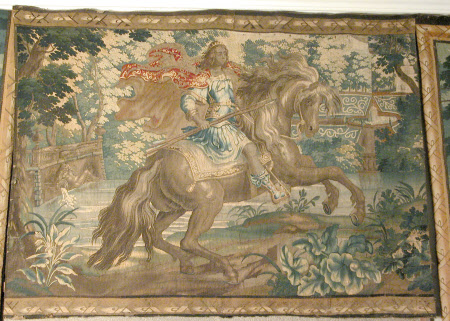The Story of Circe
Wauters, Cockx and de Wael
Category
Tapestries
Date
circa 1680 - circa 1700
Materials
Tapestry, wool and silk, 7 warps per cm
Place of origin
Antwerp
Order this imageCollection
Cotehele, Cornwall
NT 348248
Summary
A set of four tapestries of the Story of Circe, tapestry, wool and silk, 7 warps per cm, by Wauters, Cocx and de Wael, Antwerp, after designs by Pieter Spierinckx and Jan Ijkens, c. 1680-1700.
Full description
The four tapestries at Cotehele form part of a larger series of ‘The Story of Circe’. In 1682 the Antwerp firm of Wauters, Cocx and de Wael bought from the stock of the deceased Michiel Wauters seven cartoons in of the Story of Circe by ‘Spirinck and Eyckens’ (Denucé 1936, p. 98). Michiel Wauters, who died in 1679, is not known to have produced any tapestries after these cartoons, but between 1682 and 1698 Wauters, Cocx and de Wael produced numerous editions of the set, which seem to have been aimed almost exclusively at the English market (Delmarcel and van Tichelen 1996, pp. 61-66). Although the original set of cartoons included seven subjects, most of the sets sold had only six, which are named in the various documents and can be identified as follows: ‘The Companions of Ulysses arriving at the Palace of Circe’; ‘Circe offering a magic Potion to one of Ulysses’ Companions’; ‘Mercury showing Ulysses the way to Circe’s Palace’; ‘An attendant of Circe showing the marble statue of Picus to one of Ulysses’s Companions’; ‘Circe failing to bewitch Ulysses’; and ‘Picus Hunting on Horseback’. The seventh subject is not named but may have been ‘Picus refusing Circe’, the design taken from a print by Antonio Tempesta, an example of which survives at Uppark (Hefford 1983, fig. 27). A set of six was sold in 1995, and various other partial sets have appeared on the art market or are in private collections (de Meûter 2003, p. 137; Delmarcel and van Tichelen 1996, pp. 61-66). At Cotehele there are small fragments from ‘The Companions of Ulysses arriving at the Palace of Circe’ (348248.3) and ‘Circe failing to bewitch Ulysses’ (348248.4), and two larger fragments from ‘Picus Hunting’ (348248.1, 348248.2). Only the fragment representing ‘Circe’ at Cotehele has remnants of its original border, composed of leaves and flowers tied with ribbons on a brown ground. A very similar border can be seen on the ‘Children’s Games’ tapestries which hang in the Red Room, and which were woven by Philip Wauters, Michiel Wauters’s brother. The cartoons for the set were described in 1682 as by ‘Spirinck and Eyckens’. Pieter Spierinckx was an Antwerp painter who contributed to at least 15 sets of tapestry designs for the major Antwerp tapissiers and entrepreneurs in the late 17th and early 18th centuries. His oeuvre has recently been examined by Ingrid de Meûter (de Meûter 2001; 2003). Spierinckx was highly regarded as a landscape artist and was often called upon to collaborate with others by providing landscape backgrounds as a setting for figures, still lives and so on, both in paintings and tapestry designs. On the ‘Circe’ tapestries his collaborator is described as ‘Eyckens’, which could refer to either Jan Ijkens (1613-1679) or his son Pieter (1648-1695), both of whom were active as painters and tapestry designers in Antwerp; on stylistic grounds de Meûter has attributed the figures in the ‘Circe’ series to the father, Jan (de Meûter 2003, p. 137). (Helen Wyld, 2010)
Provenance
First recorded at Cotehele c. 1840; left at Cotehele when the property was accepted in lieu of tax from Kenelm, 6th Earl of Mount Edgcumbe (1873-1965) and transferred to the National Trust in 1947; amongst the contents accepted in lieu of estate duty by H M treasury and transferred to the National Trust in 1974.
Credit line
Cotehele House, The Edgcumbe Collection (The National Trust)
Makers and roles
Wauters, Cockx and de Wael , workshop possibly Maria Anna Wauters (c.1656 - 1703), workshop Pieter Spierinckx (1635 - 1711), designer attributed to Jan Ijkens (Antwerp, 1613 - 1679), designer
References
de Meûter, 2001: Ingrid de Meûter, 'L'oeuvre reconstitué du peintre anversois Pieter Spierinckx (1635-1711), créateur de cartons de tapisseries', Bulletin des Musées royaux d'art et d'histoire vol. 72 (2001), pp. 121-152 de Meûter, 2003: Ingrid De Meûter, 'Le peintre anversois Pieter Spierinckx,1635-1711, créateur de cartons de tapisserie', in Koenraad Brosens (ed.), Flemish tapestry in European and American Collections, Turnhout 2003, pp.133-152 Delmarcel and van Tichelen, 1994: Guy Delmarcel and Isabelle van Tichelen, ‘La tapisserie des Pays-Bas Meridionaux sous l’Ancien Régime’, in Les Fresques Mobiles du Nord: Tapisseries de nos regions: XVIe – XXe siècle, exh. cat. Antwerp 1994 Hefford, 1983: Wendy Hefford, ‘The Chicago Pygmalion and the “English Metamorphoses”’, The Art Institute of Chicago: Museum Studies, 10 (1983), pp. 93-117 Marillier, 1940: Henry C Marillier, ‘The English Metamorphoses: a confirmation of origin’, Burlington Magazine, vol. 76, no. 443 (Feb. 1940), pp. 60-63 Denucé, 1936: Jean Denucé, Antwerpsche tapijtkunst en handel, Antwerp 1936 Denucé, 1931: Jean Denucé, Kunstuitvoer in de 17e eeuw te Antwerpen: de firma Forchoudt, Antwerp 1931
